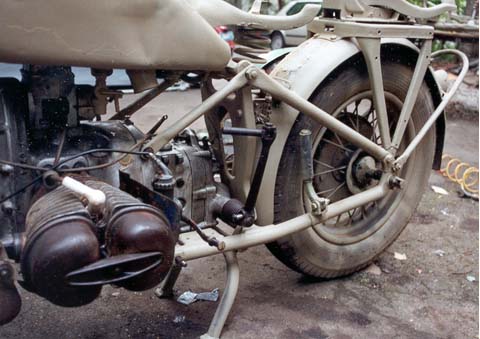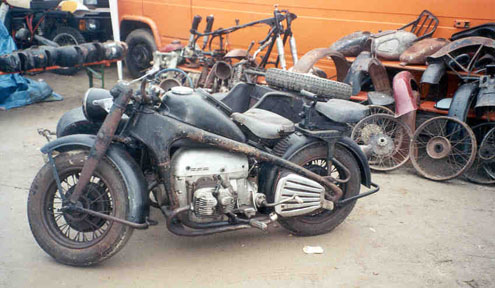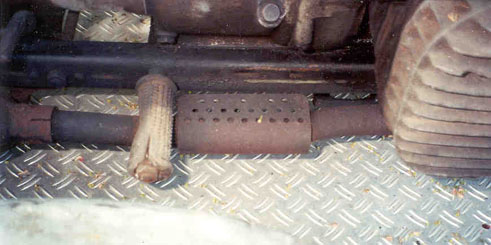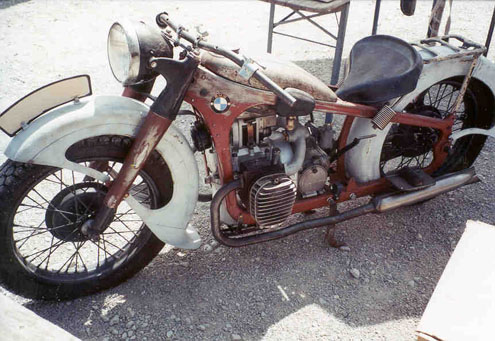
| PHOTO ARCHIVE | |
| Bike Photos | |
| Gas Tank Photos | |
| R75-KS750 Photos | |
| BMW LITERATURE | |
| Sales Brochures | |
| Parts Manuals | |
| Repair Manuals | |
| Service Bulletins | |
| Road Tests | |
| Other Literature | |
| PARTS & BIKES | |
| For Sale | |
| Wanted | |
| GENERAL | |
| Terms, etc. | |
| About Me | |
| EMAIL ME | |
| John Lacko | |
| HOME | |
| Go to Home Page | |





Another view of the same bike, this time illustrating the rear passenger footpeg. Early R75s used a straight footpeg, as seen in this photo.

Here's what the later (and more common) rear footpeg looks like. This is also a nice view of a very-very-very late R75 kickstart lever, which unlike the two types used before it, folds out of the way when not in use. An original spark plug cap (less metal shielding) is still on the bike.
Speaking of foot pegs - I thought this would be a good place to introduce a listing of R75 changes by serial number. It's something that I've compiled over a number of years by noting any references in R75 parts books, service manuals, and owners manuals to changes. You'll notice that the changes stop about 5,000 bikes from the end - until I find some later manuals, this is all I could gather. jl
R75 Changes by Serial Number
| Serial Number | Description of Change | Comments |
|---|---|---|
| 750101 | Change to new front brake cable adjuster | |
| 750601 | Change to new camshaft | |
| 751300 | Change to new rear brake pedal | |
| " | Change to new rear motor mount bolt and footpeg spacer | Now longer, for use with new brake pedal |
| 751301 | Change to new sidecar driveshaft lock (slider) and keys | Heavier to prevent wear/breakage |
| 751591 | Change to new trans output shaft | New profile |
| 752350 | Change to new foot shifter return spring in trans | Larger diameter wire |
| 754541 | Change to tank shifter lever mounting system | |
| 755040 | Change to new foot shifter anchor lever | |
| 755585 | Change to new seal design on rear wheel drive gear | Improved design |
| 755901 | "Sperren" lever changed to new self-locking design | Old lever could accidentally catch on your pants and throw the bike into two-wheel drive at speed, causing you to go straight off the road at the next curve, or blow up the rear drive unit |
| 756001 | Change to Bosch sparkplug caps | Siemens caps before |
| " | Change to new front fork springs | Larger diameter wire |
| 756522 | Brake light discontinued | |
| " | Sidecar rear light discontinued | |
| 757010 | Change to improved lower fork leg covers | Spring-loaded buttons now lock them in place |
| 757501 | Change to front fork dampening | Dampening improved |
| 758001 | Tow hook added as standard equipment | |
| " | Sidecar heating system became available | |
| 758015 | Trans changed to 4 forward off-road gears | was 3 forward before |
| 758356 | Change to front fender | Modified to eliminate 'flap' |
| " | Change to new front fender lower brace | For modified fender |
| " | Front fender lower brace bolted to fender with standard nuts | Wing nuts were used before |
| 758600 | Change to new 160mm front fender | |
| " | Change to new front fender upper brace | Longer brace for 160mm fender |
| 759050 | Sidecar frame left side leaf spring mounting bracket made to be removable | Was welded on before |
| 759580 | Battery strap bolt changed to new style | Was standard bolt |
| 760704 | Change to curved left rear footrest bracket for more ground clearance | Was straight before |
| 760800 | Front license plate no longer installed | License plate brackets are still there though |
| 761001 | Change to new right rear footrest bracket | Rubber pad now 'ahead' of mounting holes rather then 'over' them for easier access to mounting nuts |
| 761250 | Change to 160mm rear fender | |
| 761504 | Sidecar drive unit brake backing plate changed to cast iron | Was aluminum before |
| 762260 | Change to rubber fork gaiters on front forks | Were steel before |
| 762337 | Sidecar drive unit inner housing changed to cast iron | Was aluminum before |

This photo of an R75 was taken in a vehicle park just after the war. By the look of the tank and front fender, this bike saw a little action. Note the damaged and destroyed cars in the background.

The same fellow as in the previous photo, this time trying out a military R4. This fellow had a real appreciation for German bikes, and owed several of them for decades after the war.

I found this KS750 for sale at a swap meet in Germany in 1999. All in all it's a great find, and ready for restoration. The parts sprinkled around the back of the photo give you an idea of what you can find there if you know what you're looking for. Most of the parts are for smaller displacement bikes, many of which were not widely imported into the USA.

Another bike for sale in Germany was this French military Gnome Rhone. Darn few of these ever found their way to North America, so they are a real treat to see in person. Note the interesting shape of the flat twin engine.

In the last 10 years a lot of German bikes have come out of Russia, but this has got to be the best one I have seen. Whoever restored this bike sure knew what they were doing. The missing front fender brace and skid pan are the only faults I can find. Even many of the minor details are the right mix (for example: 180mm rear fender with later 160mm front fender with early style rear foot peg with air filter tank with screw on emblems [but no kneepads] - this mix is dead-nuts right for a short range of serial numbers).

Most folks think that foot boards were fitted to all R12's, but late in the run (around 1941) BMW switched to a simpler footpeg setup. It's just a continuation of the rear motor mount bolt. To keep the riders toes away from the hot pipe, the factory fitted these simple stamped steel shields on each side. This is the first original set of heat shields that I've seen still mounted on a bike (in person I mean).

A good friend of mine bought this R12 "kit" bike not too long ago. It has some repro parts on it, but it was compete with everything you'd need - just add restoration! Hopefully I'll have an "after" photo in a year or so.



